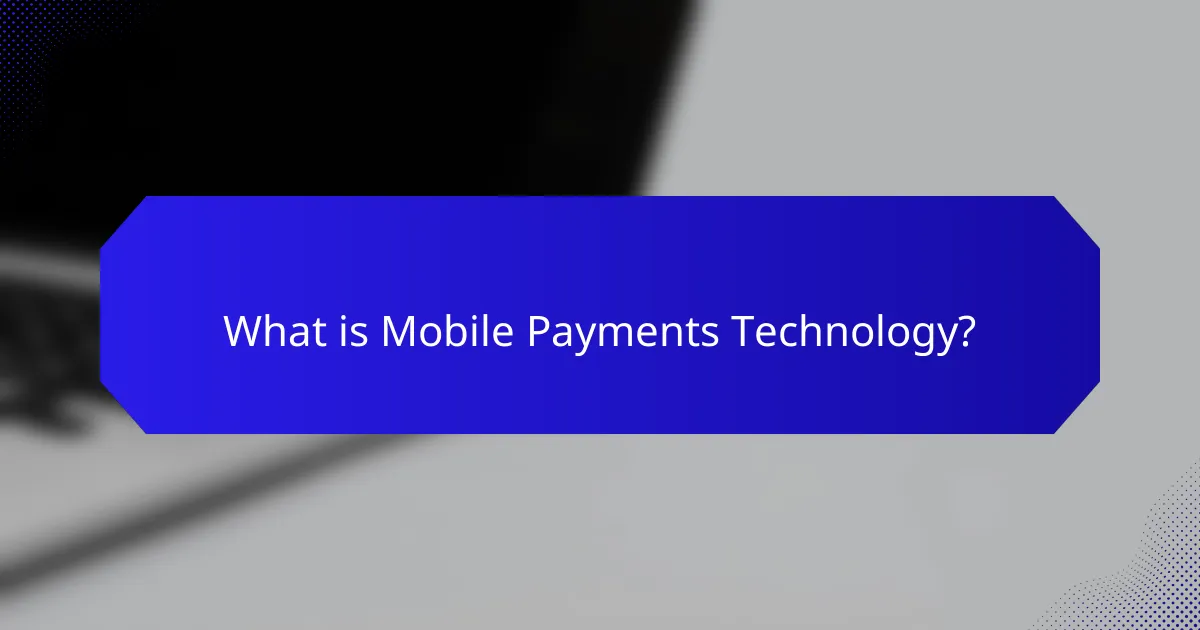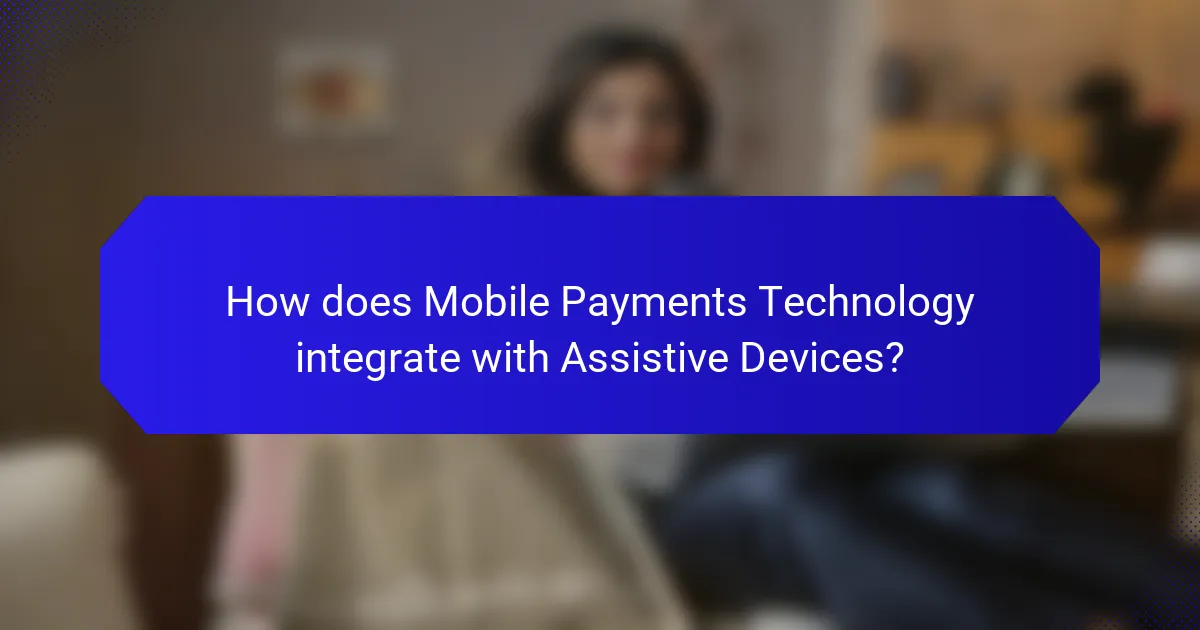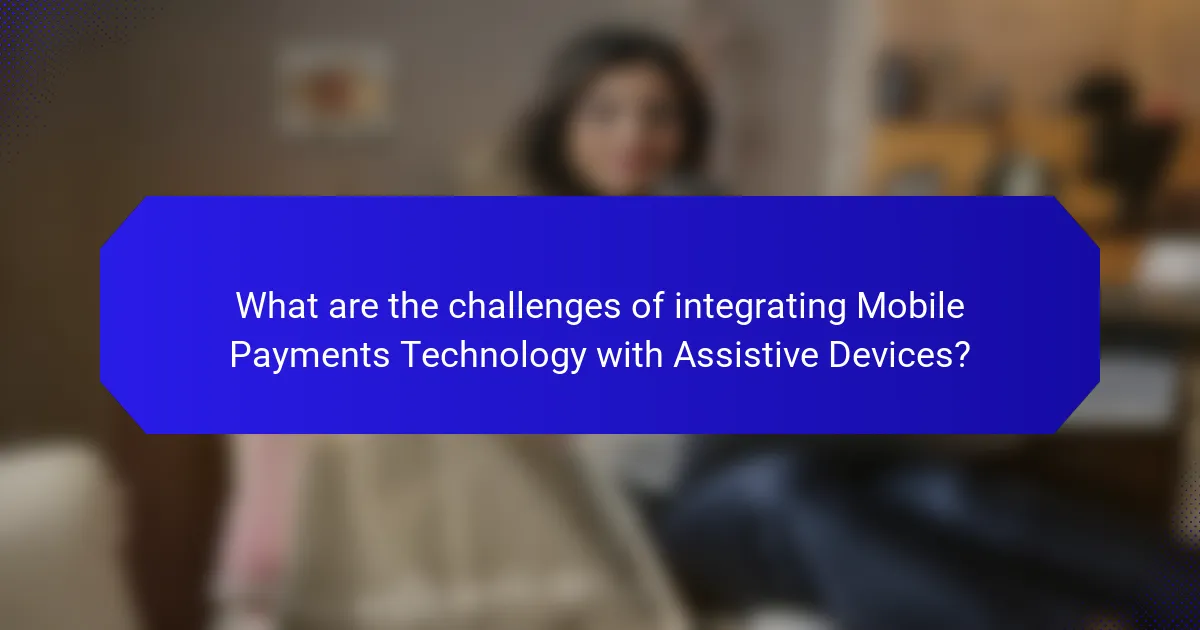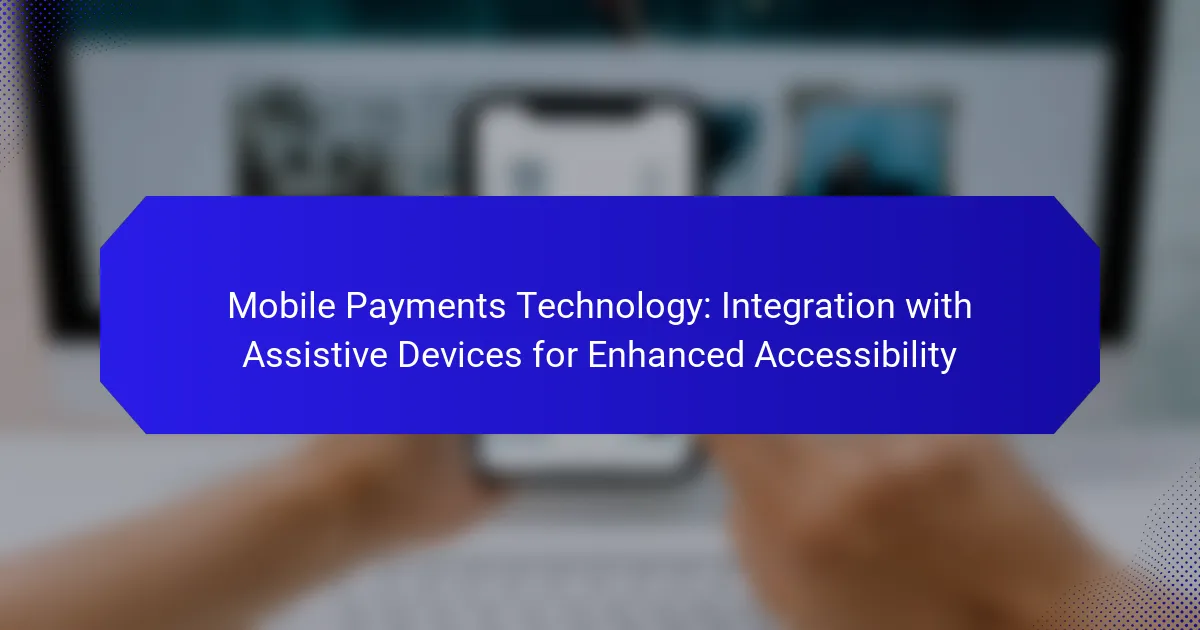Mobile payments technology enables users to conduct financial transactions through mobile devices, utilizing applications or digital wallets linked to bank accounts or credit cards. This technology supports payment processing via Near Field Communication (NFC) or QR codes and is projected to exceed $12 trillion in global market value by 2025. The article explores the integration of mobile payments with assistive devices to enhance accessibility for users with disabilities, highlighting the importance of compatibility, user interface design, and security. It addresses the challenges faced in this integration, including technical compatibility issues and the necessity for secure, user-friendly solutions, emphasizing the need for inclusive payment options for the 15% of adults in the U.S. living with disabilities.

What is Mobile Payments Technology?
Mobile payments technology allows users to make financial transactions using their mobile devices. This technology enables payments through applications or digital wallets. Users can link their bank accounts or credit cards to these apps. Mobile payments can be processed via Near Field Communication (NFC) or QR codes. According to Statista, the global mobile payment market is projected to reach over $12 trillion by 2025. This growth indicates widespread adoption and convenience in financial transactions. Mobile payments enhance user experience by offering quick and secure payment options.
How does Mobile Payments Technology function?
Mobile payments technology functions by enabling transactions through devices like smartphones and tablets. It uses methods such as Near Field Communication (NFC) and QR codes for secure payments. The user initiates a payment by tapping their device or scanning a code. This action connects to a payment processor that verifies the transaction. The payment processor communicates with the user’s bank to authorize the payment. Once approved, the funds are transferred to the merchant’s account. This system enhances convenience and speed in transactions. According to a report by Statista, mobile payment transactions are expected to surpass $1 trillion by 2023, indicating rapid adoption and growth in this technology.
What are the key components of Mobile Payments Technology?
The key components of mobile payments technology include secure payment processing, user authentication, and communication protocols. Secure payment processing ensures that transactions are encrypted to protect sensitive information. User authentication may involve methods such as biometrics, passwords, or two-factor authentication to verify the identity of the user. Communication protocols like NFC (Near Field Communication) and QR codes facilitate the transfer of payment information between devices. Additionally, mobile wallets store payment information securely for easy access. These components work together to create a seamless and secure payment experience for users.
How do security measures impact Mobile Payments Technology?
Security measures enhance the integrity and trustworthiness of mobile payments technology. They protect sensitive user data from unauthorized access and fraud. Encryption is a primary security measure that safeguards transaction information. Biometric authentication, such as fingerprint scanning, adds an extra layer of security. According to a 2021 report by Statista, 43% of mobile payment users cite security concerns as a barrier to adoption. Strong security protocols can increase user confidence and drive wider acceptance of mobile payment systems. Regular updates and compliance with industry standards are essential for maintaining security. Overall, effective security measures are crucial for the success and growth of mobile payments technology.
What are the advantages of Mobile Payments Technology?
Mobile payments technology offers several advantages, including convenience and speed. Users can make transactions quickly without needing cash or cards. This technology allows for contactless payments, enhancing the user experience. Mobile payments also integrate with various assistive devices, improving accessibility for individuals with disabilities. According to a study by the Federal Reserve, 80% of consumers find mobile payments easier than traditional methods. Additionally, mobile payments often provide enhanced security features like encryption and biometric authentication. These features help protect user data and reduce fraud risks. Overall, mobile payments technology streamlines financial transactions while promoting inclusivity.
How does Mobile Payments Technology enhance user convenience?
Mobile payments technology enhances user convenience by enabling quick and seamless transactions. Users can make payments using their smartphones without needing cash or cards. This technology supports contactless payment methods, reducing transaction time significantly. For example, studies show that contactless payments can process transactions in under a second. Additionally, mobile payments allow users to store multiple payment methods in one app. This simplifies the purchasing process, as users can switch methods easily. The integration of biometric security features, such as fingerprint scanning, also adds an extra layer of convenience and safety. Moreover, mobile payments facilitate online shopping, allowing for instant purchases from anywhere.
What economic benefits does Mobile Payments Technology provide to businesses?
Mobile Payments Technology provides significant economic benefits to businesses. It enhances cash flow by facilitating faster transactions. Businesses experience reduced transaction costs compared to traditional payment methods. Mobile payments also minimize the need for cash handling, lowering security risks and related expenses. Increased customer convenience leads to higher sales volumes. According to a study by Statista, mobile payment transactions are projected to exceed $10 trillion by 2025, indicating a growing market. Additionally, businesses can leverage data analytics from mobile payments to optimize inventory and marketing strategies. This technology also supports contactless payments, which have surged in demand, especially post-pandemic. Overall, the integration of mobile payment technology fosters efficiency and boosts profitability for businesses.

How does Mobile Payments Technology integrate with Assistive Devices?
Mobile payments technology integrates with assistive devices by enabling seamless transaction processes for users with disabilities. This integration allows assistive devices, such as screen readers and voice recognition software, to facilitate mobile payment transactions. For example, mobile payment apps can be designed to be compatible with screen readers, providing audio feedback during the payment process. Additionally, voice-activated payments enable users to complete transactions hands-free, enhancing accessibility. Research indicates that 15% of adults in the U.S. have some form of disability, highlighting the necessity for inclusive payment options. The adoption of mobile payments among assistive device users can lead to increased independence and financial autonomy.
What types of Assistive Devices are compatible with Mobile Payments Technology?
Assistive devices compatible with mobile payment technology include smartphones, tablets, and dedicated payment terminals. Smartphones and tablets often have built-in NFC (Near Field Communication) capabilities. These devices allow users to make payments through apps or digital wallets. Additionally, specialized devices like accessible point-of-sale terminals are designed for users with disabilities. These terminals often feature voice guidance and tactile buttons. Many of these devices are designed to enhance usability for individuals with visual or motor impairments. Compatibility with mobile payment systems can vary based on the device’s software and hardware capabilities.
How do smartphones and tablets facilitate Mobile Payments for users with disabilities?
Smartphones and tablets facilitate mobile payments for users with disabilities through accessibility features. These devices offer voice recognition for hands-free transactions. They include screen readers that convert text to speech, aiding visually impaired users. Touchscreens allow for easy navigation and selection of payment options. Haptic feedback provides tactile confirmation of actions, enhancing usability. Many payment apps support customizable settings for individual needs. Additionally, biometric authentication ensures secure and straightforward access. These features collectively improve the payment experience for users with disabilities.
What role do wearable devices play in Mobile Payments integration?
Wearable devices play a crucial role in mobile payments integration by facilitating contactless transactions. They enable users to make payments conveniently through smartwatches or fitness trackers. These devices often utilize NFC (Near Field Communication) technology for secure transactions. According to a report by Statista, the global market for wearable payment devices is expected to reach $62 billion by 2025. This growth indicates increasing consumer adoption. Wearables enhance user experience by allowing quick access to payment options without needing a smartphone. They also promote financial inclusivity, especially for individuals with disabilities. Thus, wearable devices significantly enhance the efficiency and accessibility of mobile payments.
How does integration improve accessibility for users?
Integration improves accessibility for users by enabling mobile payment technologies to work seamlessly with assistive devices. This compatibility allows users with disabilities to engage more effectively in transactions. For instance, voice-activated systems can assist visually impaired users in navigating payment interfaces. Additionally, haptic feedback can provide tactile responses for users with hearing impairments. Research shows that 15% of adults in the U.S. have some form of disability, highlighting the need for accessible payment solutions. By integrating assistive technologies, businesses can enhance user experiences and ensure inclusivity in financial transactions.
What are the specific accessibility features of Mobile Payments Technology?
Mobile payments technology includes several specific accessibility features. These features enhance usability for individuals with disabilities. Voice recognition allows users to make transactions via spoken commands. Screen readers provide audio feedback for visually impaired users. Haptic feedback offers tactile confirmation of actions taken. Customizable interfaces enable users to adjust settings according to their needs. Compatibility with assistive devices, like hearing aids, improves transaction clarity. NFC (Near Field Communication) technology facilitates easy tap-to-pay options. These features collectively ensure that mobile payments are accessible to a broader audience.
How do these features assist individuals with different disabilities?
Mobile payment technology features assist individuals with different disabilities by enhancing accessibility and usability. Features like voice recognition enable visually impaired users to navigate payment processes. Touchless payment options allow individuals with mobility impairments to complete transactions without physical contact. Customizable interfaces cater to users with cognitive disabilities, simplifying the payment experience. Haptic feedback provides sensory confirmation for users who are deaf or hard of hearing. Research indicates that 15% of adults in the U.S. have some form of disability, highlighting the importance of inclusive technology. These features collectively empower individuals with disabilities to participate more fully in financial transactions.

What are the challenges of integrating Mobile Payments Technology with Assistive Devices?
The challenges of integrating mobile payments technology with assistive devices include technical compatibility, user interface design, and security concerns. Technical compatibility issues arise due to diverse operating systems and hardware specifications of assistive devices. Many assistive devices may not support the latest mobile payment protocols, leading to integration difficulties. User interface design poses challenges as assistive devices often require specialized interfaces. These interfaces must accommodate various disabilities, complicating the development of a standard payment solution.
Security concerns are critical as assistive device users may be more vulnerable to fraud. Ensuring secure transactions while maintaining ease of use is a significant hurdle. Additionally, there is a lack of standardization in assistive technologies, which can hinder widespread adoption of mobile payment solutions. According to a report by the World Health Organization, approximately 15% of the global population lives with some form of disability, highlighting the importance of addressing these integration challenges for enhanced accessibility.
What technical barriers exist in the integration process?
Technical barriers in the integration process of mobile payments with assistive devices include compatibility issues, security concerns, and limited accessibility features. Compatibility issues arise when different systems do not communicate effectively. This can lead to failures in transaction processing. Security concerns involve protecting sensitive user data during transactions. Many assistive devices may not meet current security standards. Limited accessibility features can hinder usability for individuals with disabilities. Some mobile payment systems lack necessary adaptations for screen readers or voice commands. These barriers can significantly impact the effectiveness of mobile payment solutions in enhancing accessibility.
How can developers overcome these technical limitations?
Developers can overcome technical limitations in mobile payments technology by implementing adaptive design principles. They can enhance accessibility by ensuring compatibility with various assistive devices. Integrating voice recognition features can facilitate easier navigation for users with disabilities. Utilizing standardized APIs can improve interoperability between payment systems and assistive technologies. Conducting user testing with diverse groups can identify specific barriers and inform better design choices. Additionally, following guidelines from the Web Content Accessibility Guidelines (WCAG) can ensure compliance and improve user experience. Research shows that inclusive design increases usability for all users, not just those with disabilities.
What user experience challenges arise from integration issues?
Integration issues in mobile payments technology can lead to significant user experience challenges. Users may encounter difficulties in accessing payment features due to compatibility problems with assistive devices. This can result in frustration and decreased usability for individuals relying on these technologies. Additionally, inconsistent performance across different platforms can confuse users, impacting their confidence in the payment system. Limited support for various assistive technologies can create barriers for users with disabilities. Furthermore, integration failures may lead to transaction errors, causing delays and potential financial loss for users. These challenges highlight the need for seamless integration to improve accessibility and enhance overall user experience.
What strategies can enhance the integration of Mobile Payments Technology with Assistive Devices?
Enhancing the integration of Mobile Payments Technology with Assistive Devices requires several strategies. First, developing user-friendly interfaces is crucial. These interfaces should accommodate various disabilities, ensuring accessibility for all users. Second, incorporating voice recognition technology can facilitate hands-free transactions. This feature allows users with mobility impairments to make payments easily. Third, ensuring compatibility with a wide range of assistive devices is essential. This compatibility includes screen readers and alternative input methods. Fourth, providing comprehensive training and support can help users understand the technology. Educational resources should be tailored to different user needs. Fifth, engaging with users during the design process can yield valuable insights. User feedback can guide improvements and enhance usability. Finally, implementing robust security measures is vital. Users must feel safe when conducting transactions through assistive devices. These strategies collectively improve the integration of mobile payments with assistive technology, enhancing accessibility for users.
How can user feedback inform improvements in integration?
User feedback can significantly inform improvements in integration by providing insights into user experiences and challenges. This feedback highlights specific pain points users encounter while interacting with mobile payment technologies and assistive devices. For example, users may report difficulties in navigation or accessibility features. Addressing these issues can lead to targeted enhancements in the integration process.
Additionally, user feedback can reveal preferences for certain functionalities or features that are lacking. By analyzing this data, developers can prioritize updates that align with user needs. Research shows that companies that actively incorporate user feedback into their development processes see a 15% increase in user satisfaction.
This direct correlation demonstrates the value of user insights in refining integration strategies. Ultimately, leveraging user feedback fosters a more user-centric approach, leading to improved accessibility and a better overall experience.
What best practices should developers follow to ensure effective integration?
Developers should follow several best practices to ensure effective integration of mobile payments technology with assistive devices. First, they must prioritize user experience by designing intuitive interfaces. These interfaces should accommodate various accessibility needs, such as voice commands and screen readers.
Second, developers should conduct thorough testing with actual users of assistive devices. This testing helps identify usability issues that may not be apparent during standard testing. Third, they should adhere to established accessibility standards, such as the Web Content Accessibility Guidelines (WCAG). Compliance with these guidelines ensures that applications are usable by individuals with disabilities.
Moreover, developers should implement robust error handling and provide clear feedback to users. This practice enhances the overall experience by guiding users through potential issues. Lastly, they should keep up with technological advancements in both mobile payments and assistive technologies. Staying informed allows developers to integrate new features that improve accessibility.
These practices collectively lead to a more inclusive and effective integration of mobile payments technology with assistive devices.
What are the future trends in Mobile Payments Technology and Assistive Devices?
Future trends in mobile payments technology include increased integration with assistive devices. This integration aims to enhance accessibility for users with disabilities. Voice recognition technology is becoming more prevalent in mobile payment applications. This allows users to complete transactions using voice commands. Biometric authentication methods, like [censured] recognition and fingerprint scanning, are also gaining traction. They provide secure and convenient payment options. Moreover, the use of augmented reality (AR) is expected to grow. AR can help visually impaired users navigate payment processes more effectively. Additionally, contactless payment methods are becoming standard. They allow for quicker transactions, which is beneficial for all users, including those with mobility challenges. The global mobile payment market is projected to reach $12.06 trillion by 2027, reflecting its rapid growth. This trend indicates a strong demand for accessible payment solutions integrated with assistive technologies.
How might advancements in technology shape the future of Mobile Payments integration?
Advancements in technology will significantly shape the future of mobile payments integration. Innovations such as biometric authentication will enhance security and user convenience. For instance, fingerprint and [censured] recognition technology are becoming standard in mobile devices. These features streamline the payment process, making transactions faster and more secure.
Additionally, the integration of artificial intelligence will personalize user experiences. AI can analyze spending patterns and suggest tailored payment options. This could lead to increased user engagement and satisfaction.
Furthermore, the expansion of 5G networks will improve transaction speeds and reliability. With faster data transfer, mobile payments can process in real-time, reducing wait times at checkout. This is crucial for both consumers and retailers.
Blockchain technology may also play a role in securing mobile payments. Its decentralized nature can reduce fraud and enhance transparency. As more businesses adopt blockchain, trust in mobile payment systems will likely increase.
In summary, advancements in biometric technology, AI, 5G, and blockchain will drive the evolution of mobile payments integration. Each of these technologies addresses key aspects of security, speed, and user experience.
What innovations are expected to improve accessibility in Mobile Payments?
Innovations expected to improve accessibility in mobile payments include voice recognition technology and biometric authentication. Voice recognition allows users to make transactions through spoken commands, enhancing usability for individuals with visual impairments. Biometric authentication, such as fingerprint and [censured] recognition, simplifies the payment process and increases security.
Additionally, integration with assistive devices like screen readers and haptic feedback systems is anticipated. Screen readers provide auditory feedback, guiding users through payment processes. Haptic feedback can alert users to transaction confirmations or errors through vibrations.
Furthermore, the development of inclusive design principles is crucial. This approach ensures that mobile payment applications cater to diverse user needs from the outset. Research shows that 15% of the global population has some form of disability, highlighting the importance of accessibility in payment technologies.
These innovations collectively aim to create a more inclusive mobile payment ecosystem.
What practical tips can users follow to maximize accessibility with Mobile Payments Technology?
Users can maximize accessibility with mobile payments technology by enabling voice commands. Voice recognition allows users with visual impairments to navigate payment options easily. Users should also adjust font sizes and contrast settings for better readability. This can help those with visual difficulties process information more effectively.
Utilizing NFC technology can enhance accessibility, allowing contactless payments for users with mobility challenges. Users should ensure their devices are compatible with assistive technologies, such as screen readers. Regular updates to payment apps can improve functionality and accessibility features.
Finally, users should familiarize themselves with the app’s layout and features to streamline their payment experience. Training sessions or tutorials can provide helpful insights into using mobile payment systems effectively.
Mobile Payments Technology refers to the systems that allow users to conduct financial transactions through mobile devices, utilizing applications or digital wallets linked to bank accounts or credit cards. This article explores the integration of mobile payments with assistive devices, highlighting key components such as secure processing, user authentication, and communication protocols. It also discusses the advantages of mobile payments, including convenience and speed, while addressing the accessibility features that assist individuals with disabilities. Furthermore, the article examines the challenges of integration, user experience, and future trends in enhancing accessibility through technological advancements.
